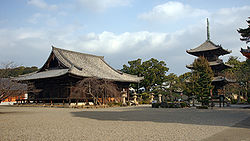- Dōjō-ji
-
Dōjō-ji
道成寺
Hondō (1357) and Three-storey pagoda (1763) Information Mountain Name 天音山 Denomination Tendai Venerated Senjū Kannon Founded 701 Address 1738 Kanemaki, Hidakagawa, Wakayama Prefecture Country Japan Website http://www.dojoji.com/ Dōjō-ji (道成寺) is a Tendai school Buddhist temple in Hidakagawa, Wakayama Prefecture, Japan. Founded in 701, it has given name to a number of plays, the statues of Senjū Kannon, Nikkō Bosatsu, and Gakkō Bosatsu are National Treasures, and there are a number of other Important Cultural Properties.[1][2]
Contents
Buildings
- Hondō (1357); 7x5 bay, single-storey, irimoya-zukuri, tiled roof; (Important Cultural Property)[3]
- Niōmon (1694); 3 bay, single-door rōmon, irimoya-zukuri, tiled roof; (Important Cultural Property)[4]
- Three-storey pagoda (1763) (Prefecturally-designated Cultural Property)[5]
- Shoin (1702) (Prefecturally-designated Cultural Property)[5]
Treasures
 Dōjō-ji Engi emaki (Muromachi period); Important Cultural Property
Dōjō-ji Engi emaki (Muromachi period); Important Cultural Property
- Wooden statue of Senjū Kannon (木造千手観音立像) (Heian period) (National Treasure)[6]
- Wooden statues of Nikkō Bosatsu and Gakkō Bosatsu (木造菩薩立像 (伝日光・月光菩薩)) (Heian period) (National Treasures)[7]
- Wooden statue of Senjū Kannon (木造千手観音立像) (Nara period) (Important Cultural Property)[8]
- Wooden-core lacquer statue of Senjū Kannon (木心乾漆千手観音立像) (Nara period) (Important Cultural Property)[9]
- Wooden statue of Jūichimen Kannon (木造十一面観音立像) (Heian period) (Important Cultural Property)[10]
- Wooden statue of Bishamonten (木造毘沙門天立像) (Heian period) (Important Cultural Property)[11]
- Wooden statues of the Four Heavenly Kings (木造四天王立像) (Heian period) (Important Cultural Property)[12]
- Wooden statues of the Shaka Nyorai Triad (木造釈迦如来坐像及び両脇侍立像) (Nanboku-chō period) (Prefecturally-designated Cultural Property)[13]
- Dōjō-ji Engi emaki (紙本著色道成寺縁起), two scrolls (Muromachi period) (Important Cultural Property)[14][15]
- Dōtaku (Yayoi period) (Prefecturally-designated Cultural Property)[13]
Anchin and Kiyohime
 Dōjōji, Noh play
Dōjōji, Noh play
The story of monk Anchin (安珍) and spurned lady Kiyohime (清姫) who, devoured by her passion and jealousy, turns into a serpent and pursues him to his destruction, is the subject of the Noh play Dōjōji, known for the rare prominence of its dramatic prop, the temple bell;[16][17] as well as the Kabuki play Musume Dōjōji with its long onnagata buyō.[18]
See also
- Dōjōji (Noh play)
- Noh
- Japanese folklore
- List of National Treasures of Japan (sculptures)
References
- ^ "Dojoji Temple". Hidakagawa Town. http://www.town.hidakagawa.lg.jp/english/dojoji_eg.html. Retrieved 22 May 2011.
- ^ "Dojoji". Wakayama Prefecture. http://www.pref.wakayama.lg.jp/english/charm/01.html. Retrieved 22 May 2011.
- ^ "Database of National Cultural Properties". Agency for Cultural Affairs. http://www.bunka.go.jp/bsys/maindetails.asp?register_id=102&item_id=2914. Retrieved 22 May 2011.
- ^ "Database of National Cultural Properties". Agency for Cultural Affairs. http://www.bunka.go.jp/bsys/maindetails.asp?register_id=102&item_id=2915. Retrieved 22 May 2011.
- ^ a b "Wakayama bunkazai". Wakayama Prefecture. http://www.pref.wakayama.lg.jp/prefg/500700/mokuroku/mokuroku/kenkenzo.html. Retrieved 22 May 2011.
- ^ "Database of National Cultural Properties". Agency for Cultural Affairs. http://www.bunka.go.jp/bsys/maindetails.asp?register_id=201&item_id=283. Retrieved 22 May 2011.
- ^ "Database of National Cultural Properties". Agency for Cultural Affairs. http://www.bunka.go.jp/bsys/maindetails.asp?register_id=201&item_id=284. Retrieved 22 May 2011.
- ^ "Database of National Cultural Properties". Agency for Cultural Affairs. http://www.bunka.go.jp/bsys/maindetails.asp?register_id=201&item_id=5103. Retrieved 22 May 2011.
- ^ "Database of National Cultural Properties". Agency for Cultural Affairs. http://www.bunka.go.jp/bsys/maindetails.asp?register_id=201&item_id=5102. Retrieved 22 May 2011.
- ^ "Database of National Cultural Properties". Agency for Cultural Affairs. http://www.bunka.go.jp/bsys/maindetails.asp?register_id=201&item_id=4381. Retrieved 22 May 2011.
- ^ "Database of National Cultural Properties". Agency for Cultural Affairs. http://www.bunka.go.jp/bsys/maindetails.asp?register_id=201&item_id=4380. Retrieved 22 May 2011.
- ^ "Database of National Cultural Properties". Agency for Cultural Affairs. http://www.bunka.go.jp/bsys/maindetails.asp?register_id=201&item_id=4382. Retrieved 22 May 2011.
- ^ a b "Wakayama bunkazai". Wakayama Prefecture. http://www.pref.wakayama.lg.jp/prefg/500700/mokuroku/mokuroku/kenbizyutu.html. Retrieved 22 May 2011.
- ^ "Database of National Cultural Properties". Agency for Cultural Affairs. http://www.bunka.go.jp/bsys/maindetails.asp?register_id=201&item_id=1829. Retrieved 22 May 2011.
- ^ Waters, Virginia Skord (1997). "Sex, Lies, and the Illustrated Scroll: The Dojoji Engi Emaki". Monumenta Nipponica (Sophia University) 52 (1): 59–84.
- ^ Keene, Donald (1970). 20 Plays of the Nō Theatre. Columbia University Press. pp. 238–252. ISBN 0-231-03455-5.
- ^ Klein, Susan Blakeley (1991). "When the Moon Strikes the Bell: Desire and Enlightenment in the Noh Play Dojoji". Journal of Japanese Studies (The Society for Japanese Studies) 17 (2): 291–322.
- ^ "Kabuki repertoire - Kyoganako musume dojoji". National Theatre of Japan. http://www2.ntj.jac.go.jp/unesco/kabuki/en/5/5_04_09.html. Retrieved 22 May 2011.
External links
- (Japanese) Dōjō-ji - homepage
- (English) Dōjō-ji - English language site
Buddhist temples in Japan Japanese Buddhist architecture Architectonic elements Mon (gates) Buildings Chinjusha · chōzuya/temizuya · -dō · main hall (kon-dō, hon-dō, butsuden) · kuri · kyōzō or kyō-dō · shoinTō or Buttō (pagodas) Styles Others A-un · kenSchools and objects of worship Major schools Zen schools Nanto rokushū Objects of worship Amida Nyōrai · Benzaiten · Dainichi Nyorai · Jizō · Kannon · Marishi-ten · Shaka Nyorai · Shitennō (Four Kings) · Twelve Heavenly Generals (Jūni Shinshō) · Yakushi NyoraiOther elements Implements kei (ritual gong) · mokugyōOthers bussokuseki · butsudan · Glossary of Japanese Buddhism · Japanese Buddhist pantheon · jingū-ji · miyadera · saisenbakoCategories:- Buddhist temples in Wakayama Prefecture
- Japanese pagodas
Wikimedia Foundation. 2010.

